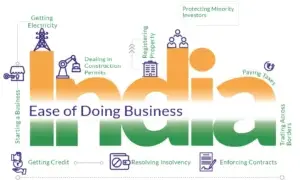This is a concern not many would have at the moment but might manifest five to ten years from now. That time, however, it will be too late to do anything. By 2035, the Kashmir Valley may no longer be the poetic, snow-kissed landscape that once enthralled saints, emperors, and seekers. If the present trajectory of unplanned development, environmental apathy, and infrastructural shortsightedness continues, the Valley is destined to mutate into a grotesque parody of its own past – a fragile ecosystem battered by greed, incompetence, and unchecked urbanization.
The Geography of Destruction
Kashmir’s geography has always been its gift and its curse. Its alpine meadows, serene lakes, and cascading rivers have long defined its soul. But in the last three decades, greed has outpaced gratitude. Hills are being shaved down to stumps for roads and hotels. Wetlands – nature’s own flood defenses – are drained and encroached upon. Forests are vanishing to make way for second homes and boutique resorts. Rivers are being straightjacketed, their natural courses throttled by concretized embankments that do more harm than good.
Ten years down the line, this geographical mutilation will lead to severe ecological consequences. Expect more landslides where there occurred none earlier. Expect flooding not as a once-in-a-decade calamity but as an annual certainty. Expect the fragile Zabarwan hills to lose their green cover, and for Dal Lake to become a dead, black pond choked and stiffled.
Kashmir was once known for its four distinct seasons, each unfolding like a slow-moving raga. But those rhythms are now broken. Snowfall has become erratic; summers longer and harsher. Winter rainfall has dwindled, impacting spring agriculture and horticulture cycles. And this is just the beginning.
With rampant construction disrupting natural wind patterns and reducing green cover, urban heat islands are already forming in Srinagar, Anantnag, and Baramulla. By 2035, parts of the Valley will experience summer temperatures touching 35-40 degrees Celsius – unimaginable just two decades ago. Glaciers that fed the Valley earlier are receding at an alarming rate. With hydrological cycles disrupted, water scarcity will grip both rural and urban Kashmir, leading to a crisis that no political or bureaucratic setup seems prepared to face.
The reckless development is not only ecological vandalism; it is social sabotage. Traditional village clusters, with their wood-and-mud homes, are giving way to concrete monstrosities. The notion of Kashmiri architecture is dying, replaced by Delhi-style duplexes and Dubai-inspired facades that jar against the Valley’s ethos.
Tourism, the supposed engine of prosperity, is now a double-edged sword. In the absence of regulatory oversight, every orchard is being converted into a parking lot, every riverfront into a resort. Locals are pushed to the margins, both spatially and economically. The cost of living is rising, housing is becoming unaffordable, and seasonal employment is no substitute for sustainable livelihoods. By 2035, expect social resentment to deepen, particularly between urban elites and rural disenfranchised communities. The Valley might wear a tourist’s smile, but behind it will simmer the frustrations of a populace made secondary to profit.
By 2035, the urban sprawl will swallow towns like Budgam, Ganderbal, Pampore, and even parts of Pulwama into a vast, overpopulated, under-planned metropolis. Public transport will remain archaic, with private cars multiplying unchecked. Traffic snarls will become daily migraines. Solid waste disposal will become a nightmare, as the Valley has yet to figure out where and how to manage its garbage.
The Culture of Short-Termism
Kashmir is not alone in this trajectory of self-sabotage. Several once-idyllic tourist destinations across India have fallen prey to unplanned expansions driven by the lure of mass tourism:
- Shimla, Himachal Pradesh: Once the summer capital of British India, Shimla is now grappling with severe water shortages, rampant illegal construction, traffic chaos, and landslides, all thanks to poorly planned tourism infrastructure.
- Manali and Kasol, Himachal Pradesh: Overrun by unregulated guesthouses, cafes, and roads, these towns face solid waste crises and river pollution, with the Beas River now carrying more plastic than snowmelt.
- Mussoorie, Uttarakhand: The ‘Queen of Hills’ suffers from relentless traffic congestion, deforestation, and collapsing civic infrastructure due to unchecked hotel construction and vehicular influx.
- Nainital, Uttarakhand: The lake that gives the town its name is now struggling with water quality issues due to untreated waste and sewage from overflowing hotels and illegal settlements.
- McLeod Ganj, Himachal Pradesh: This spiritual enclave has turned into a maze of concrete structures with limited drainage, frequent water shortages, and waste mismanagement, losing its serene charm to commercial clutter.
- Darjeeling, West Bengal: The iconic hill town battles overpopulation, landslides due to rampant hill-cutting, and water rationing, especially during the peak tourist season.
- Goa: What began as a laid-back beach haven has transformed into a densely commercialized strip plagued by sewage discharge, sand erosion, and destruction of wetlands to accommodate a growing influx of tourists.
- Ooty and Kodaikanal, Tamil Nadu: Both destinations have witnessed severe ecological degradation, lake pollution, and forest encroachments, with the Nilgiris losing their natural serenity.
- Munnar, Kerala: Once prized for its lush tea gardens and cool climate, Munnar now faces erratic land use, traffic chaos, and a boom in unauthorized resorts that encroach upon sensitive ecosystems.
- Puri, Odisha: Pilgrimage tourism has led to massive encroachment, strain on civic amenities, and unmanaged waste, threatening its coastal environment.
These examples serve as cautionary tales for Kashmir. The lessons are clear: unplanned tourism is not a development model; it is a slow-motion disaster.
Why is Kashmir hurtling toward this precipice? Because governance here is driven by the politics of optics, not outcomes. Master plans are routinely bypassed. Environmental impact assessments are mere formalities. Illegal constructions are later legalized with fines, turning crime into policy. Every new hotel is hailed as a sign of growth, never mind that it might be built on a floodplain. Officials who raise a hue and cry against this disorder are either transferred or maligned as ugly whistleblowers. Kashmir needs an immediate blueprint as a rescue plan; else the time is not far when Kashmir will no longer be Kashmir.
What Must Be Done: A Ten-Year Rescue Blueprint
- Immediate Construction Freeze: Impose a moratorium on all new commercial construction near tourist hotspots and ecologically fragile zones.
- Master Plan Enforcement: Enforce the Srinagar and district master plans with an iron hand. No building should be allowed that does not conform to zonal regulations.
- Wetland Revival Mission: Undertake a Valley-wide wetland restoration program. Resettle encroachers, treat incoming sewage, and reintroduce native flora and fauna.
- Green Tax and Eco-Fee: Implement a green tax on commercial vehicles and an ecological fee for hotels and tourist operators.
- Rural Incentivization: Provide incentives for people to stay in rural areas by improving rural healthcare, education, and employment. Reverse the urban migration trend.
- Cultural Architecture Revival: Promote and enforce use of traditional Kashmiri architectural styles through subsidies, tax benefits, and legal mandates.
- Public Awareness and Participation: The public must be made stakeholders in preserving their environment. Environmental education, village-level audits, and participatory planning can anchor long-term change.
The road to 2035 can either be one of irreversible damage or of redemptive correction. But, right now, the time is not on our side. Either we act now, or prepare to watch, helplessly, as Kashmir descends from a paradise on earth to a dystopian echo of its former glory. The question is not whether Kashmir can be saved. The question is whether we have the courage, vision, and will to do it. Sadly, we don’t have it.




